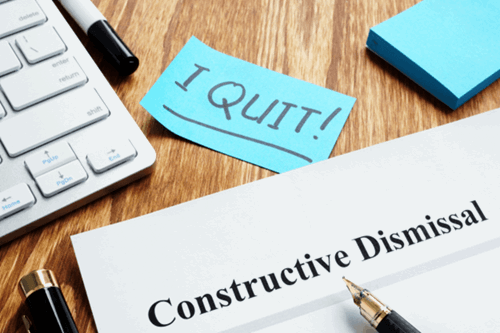Sometimes it can be complicated trying to understand constructive dismissal. When an employee resigns from their position, in extreme cases this can be referred to as a dismissal
Constructive dismissal claims can lead to the company having to pay the employee compensation and reputational damages.
Under UK law, this type of resignation is treated as a form of unfair dismissal. This article explores constructive dismissals and avoids claims associated with them.
If your business needs support on constructive dismissals then call Croner on 01455 858 132 and speak to our award-winning team.

What is constructive dismissal?
Constructive Dismissal is where an employer alters an aspect of an employee’s job or working conditions. More often than not this isn’t done to coerce the employee into resigning, it’s the employee’s response to an unfair situation.
In most instances of constructive dismissal, an employer is deemed to have committed a fundamental breach of contract. This breach provides a reason for the employee to resign in response to the employer’s conduct. After this, they may claim constructive dismissal.
As an employer, you should avoid a situation where an employee feels they have no choice but to resign.
In these occurrences, your conduct is referred to as a ‘repudiatory breach’, where the employee feels they have no option but to resign and where the employee can claim damages.
For a constructive dismissal claim to proceed to an employment tribunal, there must be a fundamental breach of either;
- The terms of the employee’s employment contract or,
- The implied terms are based on trust and confidence in the employment relationship.
The employee must have resigned because of this serious breach and not for any other reason.
Can you justify a contract breach?
The short answer here is no. If there is a financial or logistical reason for emoting or relocating an employee, and they refused, the redundancy process would most likely be the next stage.
If they didn’t reasonably refuse, the change can be enforced. A contract breach would only apply if the relocation/ demotion was unreasonable and unreasonably enforced. External pressures are relevant in relation to constructive dismissal.
Employers can use the defence of objective justification, which allows employers to apply a policy, rule or practice that would in other circumstances be unlawful indirect discrimination.
A tribunal will make a decision on whether they think the action by the employer was justified, if they find it to not be, it will be unlawful discrimination.
Whether or not you intended to breach the contract is irrelevant.
How Long Does an Employee Need to Be Employed to Make a Claim for Constructive Dismissal?
In most circumstances, an employee must have two years of service before bringing forward a claim of constructive dismissal.
If an employee doesn't fall within the qualifying service they can't make a claim.

What is the Difference Between Constructive Dismissal and Unfair Dismissal?
Constructive dismissal is a form of unfair dismissal. However, there is a difference between the two.
Constructive dismissal is when an employee is forced to resign in response to their employer’s conduct. Although it’s referred to as a “dismissal” in law, it is in practical terms a resignation.
An unfair dismissal, on the other hand, is when an employee has been dismissed in a way that is unlawful. For specific advice on unfair dismissals please contact Croner on 01455 858 132 and speak to our award-winning team.
What Constitutes Constructive Dismissal?
The focus of a constructive dismissal claim is the employer’s conduct. Let’s have a look at some examples of constructive unfair dismissal that could give your employees grounds for a constructive dismissal claim:
- Forcing your employee to work at a different location without prior agreement.
- Demotion without warning.
- Reducing or threatening to reduce your employee's salary.
- Forcing your employee to accept a significant change in the nature of their role. For example, forcing someone on day shifts to work nights.
- Making your employee work in breach of health & safety laws.
If your employee is going to resign and claim constructive dismissal, it would be as quick as reasonably appropriate for the individual situation. An employment tribunal could view any significant delay as an employee accepting the situation.

Reasons for constructive dismissal
A constructive dismissal resignation letter might include one of the following to outline their reason for resigning:
- Fundamental breach of contract: This could be a direct contradiction of your employee's role and entitlements as set out in their contract.
- An anticipated breach of contract: This is an action that shows your intention to fail to fulfil your contractual obligations.
- A breach of trust: This could be you causing damage to the reputation or career prospects of your employee.
- A "last straw" doctrine: This would likely be a series of actions or breaches of contract that result in the employee resigning. The "last" act need only relate to the past treatment of your employee.
How easy is it for an employee to make a constructive dismissal claim?
Constructive dismissal claims arise when an employee believes that you have acted in a way that made their position untenable.
The emphasis is on the employee to prove that you, the employer, were in breach. This is another differentiation between constructive and unfair dismissal. In this case, it is on the employer to prove the dismissal was fair.
The breach by the employer may not always be obvious. The employer may have done something and not realised the effect it will have on the employee. Constructive dismissal claims in employment law revolve around the position of the employee becoming unjustified.
If you are deemed to have crossed a line but it didn’t make the employee’s position untenable then it’s a different story.
If the matter reaches the employment tribunal stage, it will be determined on its own facts, and what is considered reasonable.

Should there be a grievance lodged before a constructive dismissal claim?
Under the ACAS code of practice. Employees need to lodge a formal grievance against employers in constructive dismissal claims before they resign, but this won’t always apply.
If an employee fails to lodge a grievance or doesn't communicate their dissatisfaction with their employer's conduct (for example citing intolerable working conditions) then a tribunal claim can see damages reduced by up to 25%.
As an employer, even if it seems obvious that the employee has no intention of remaining in their position, handling their grievance effectively can minimise the risk of being taken to tribunal.
Can I avoid a constructive dismissal claim by upholding a grievance or apologising?
Unfortunately, not. If you have done something wrong, then you need to uphold the grievance and put in measures to rectify the mistake and stop it from happening again.
It won’t be possible to resolve a breach by attempting to make amends if measures haven’t been put in place to stop it from happening again.

What compensation is available for constructive dismissal?
If an employee’s claim is successful, they will receive either a basic award or a compensatory award.
Basic Award
The basic award is a statutory payment that is based on an employee’s length of continuous service, age and current salary. This is calculated as:
- One and a half week’s pay for each year of employment after age 41.
- One week’s pay for each year of employment between ages 22 and 40.
- Half a week’s pay for each year of employment under the age of 22.
An employment tribunal would calculate the total based on your employee’s normal weekly gross pay at the time they were dismissed. This can be up to the maximum limit of £643 from April 2023.
A week’s pay does not usually include overtime pay. The maximum basic award payment they can receive is £19,290 from April 2023.
Compensatory Award
In some instances, a larger compensatory award will then be considered.
The upper limit for constructive dismissal compensation is currently £105,707 or 52 weeks gross salary - whichever is the lower. This is not including other expenses, such as legal representation.
Use Croner's Unfair Dismissal Calculator tool to work out how much your employee would be owed.

Can I negotiate an exit or settlement with my employee?
Employers do have an option of securing a negotiated exit with an employee, depending on the circumstances.
Assuming the employee has a solid basis for a constructive dismissal claim, there wouldn’t be any need for employers to negotiate a settlement agreement. This is an alternative to going to the tribunal and will be based on trust and confidence.
A settlement would usually result in paying a lump sum financial package. In some cases the relationship between the employer and the employee can break down prior to a formal grievance being lodged. This isn’t always the case, and the relationship can be prepared.
It is advisable to have expert legal representation when negotiating a severance with your employee, and for your employee to receive legal advice.
The biggest pitfall of not doing this is that you may end up saying the wrong thing or set in motion certain circumstances which could put a settlement with your employee at risk.
What is the time frame for constructive dismissal to become an employment tribunal claim?
The process for claiming constructive dismissal should commence within a period of 3 months less than 1 day from the date that the employee has left employment before the tribunal will accept the claim.
It needs to be lodged with ACAS as a preliminary step under their early conciliation scheme. It is important that this step is carried out properly or your employee claim can’t progress.

Get help from Croner on Constructive Dismissal.
Claims can consume a large portion of your business's time and money.
The best way to prevent a claim is to be vigilant and keep on top of employment contracts, HR policies, and terms & conditions. Keeping policies and procedures up-to-date and compliant is a good start. Bear in mind that smaller issues (while they might not be too harmful on their own) can build up.
These issues could create an environment where the employee feels like they have no choice but to resign. Investigate complaints and grievances when they come to your attention to avoid facing claims.
Have fair processes in place and follow them. Include policies on equal opportunities and discrimination. A constructive dismissal payout can be costly.
For support with a constructive dismissal, or any other HR/Employment issue, contact Croner on 0808 145 3003.
Related resources
Categories
- Business Advice
- Culture & Performance
- Disciplinary & Grievances
- Dismissals & Conduct
- Employee Conduct
- Employment Contracts and Documentation
- Employment Law
- Employment Rights Bill
- End of Contract
- Equality & Discrimination
- Health & Safety
- Hiring and Managing
- Leave & Absence
- Managing Health & Safety
- Moving
- Occupational Health
- Pay & Benefits
- Recruitment
- Risk & Welfare





